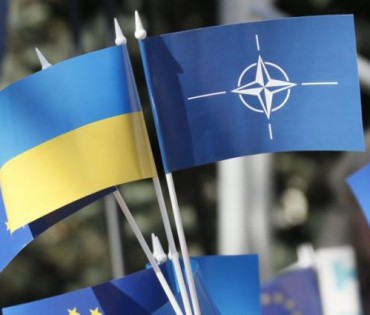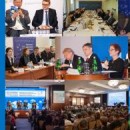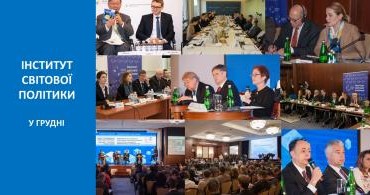Alyona Getmanchuk, Director of the Institute of World PolicyThe fact of dropping its non-aligned status has not led to a definitive1 declaration of Ukraine’s course towards NATO membership. Instead, a cautious wording has been used to meet the criteria required for the accession.
Despite political statements that Ukraine must join NATO, there are still some doubts concerning which process, indeed, has been launched by the renunciation of non-aligned status – integration into NATO or a transition to Ukraine’s undeclared neutrality.
In Ukraine’s National Security and Defence Council Staff they are considering the Swedish model of relations with NATO as an example for Ukraine in the short and medium term2; the implementation of this model is to create conditions for full membership in the future. Namely, Ukraine must achieve complete compatibility of its security and defence sector with NATO structures. Therefore, if political conditions are appropriate, Ukraine would be ready to join NATO immediately, without any NATO Membership Action Plan and other preparatory documents. In fact, in that case we can speak of the hidden integration.
From another side, Ukraine’s government circles are rather pessimistic about the existence of political conditions for Ukraine’s NATO membership in the foreseeable future. There are serious doubts about the fact that the process of joining the Alliance can start before 2020. And not only Ukraine’s readiness, but, predominantly, NATO’s readiness for this process is in question. Kyiv understands that the consensus about Ukraine in NATO is an extremely distant prospect.
Ukraine has never been so close and so far at the same time from NATO as today. On the one hand, probably for the first time in Ukraine’s history, the society supports rather strongly Ukraine’s integration into NATO. After the annexation of Crimea and the hybrid war in eastern Ukraine inspired by Russia, Ukrainians have reconsidered the threats the state is facing and understood what actually the advantage of collective security is. However, it is not evident whether this support is sustainable. It is not known to what extent this is a conscious choice, or whether it is just a reaction to an external threat.
On the other hand, Russia has significantly complicated the potential integration of Ukraine into NATO by its military aggression against Ukraine. First, the so-called NATO’s 1995 Study on Enlargement stresses that unresolved conflicts or external territorial disputes may be an obstacle to the Alliance membership. Occupied territories and a threat of further escalation in Europe make the prospect of NATO membership especially remote for Ukraine.
Secondly, Russian aggression in Crimea and eastern Ukraine has turned Ukraine from a security contributor, who participated in all, without exception, Alliance’s peacekeeping operations, into its user; and, moreover, the conflict between Russia and Ukraine is a threat to European security. However, there are some things that Ukraine could offer NATO, first of all its valuable experience in counteracting a hybrid war. In particular, it would be worthwhile to open a Hybrid War Study Center in Ukraine.
Ukraine has found itself in a kind of a vicious circle. On the one hand, NATO insists to reiterate that Ukraine has the right to choose on her own, particularly in regard to integration into NATO. On the other hand, the fact that NATO reacts to the very discussion of Ukraine’s membership in NATO demonstrates that, indeed, Ukraine does not have such a choice today.
Instead, there is a kind of geopolitical double-dealing: there is a choice, but this choice is impossible to implement. Both Brussels and Kyiv are aware of that. At the same time, we must understand another thing as well. For Ukraine today the membership in NATO is not an issue for the sake of which she would be willing to question the European and transatlantic unity. Especially, it concerns the current critical issues such as a unified Western position on the Russian aggression in Ukraine in general and, in particular, the extension of the sanctions. In this context Russia should be more interested in promoting actively Ukraine’s membership in NATO than Ukraine itself.
Giving up accession to NATO and fixing neutrality in the Constitution is one of three key concessions the majority of Ukrainians are ready for in order to gain peace (the other two are: providing the territories controlled by DNR and LNR with a special status for a certain period with partial control by Kyiv and recognition of Russian as an official language on the entire territory of Ukraine. For comparison, twice less respondents (only 6%) are ready to reconsider the Association Agreement with the EU at Russia’s request and to refuse further rapprochement with the EU. However, it should be noted that only 11% of Ukrainians are ready to refuse NATO, while 21% support providing DNR and LNR with a special status.
“Membership or nothing”
Since the signature of the Charter on a Distinctive Partnership with NATO in 1997, Ukraine has passed through a cycle during which she tested different formats within the Distinctive Partnership: from integration to non-alignment. None of these formats did fully justify itself, but the format of non-alignment turned out to be the most dangerous
one. It is during that format a part of Ukraine’s territory was annexed, and another part – de facto occupied. During the period of non-alignment Ukraine, in fact, has already tested on a model of “finlandization” when abandoning at the request of Russia its intention to integrate into NATO.
Obviously, the distinctive partnership with NATO in 2015 cannot be only a strengthened version of the distinctive partnership with NATO of the year 1997. At least due to the level of threat to Ukraine’s territorial integrity and the urgent need for effective external guarantees for the security of Ukraine, as the Budapest Memorandum has not met its goal.
Over the past year Ukraine has comprehended that even a very distinctive partnership with NATO is unable to respond to the current level of threats. Only a membership in NATO provides for such security guarantees in line with the Article 5 of the Washington Treaty. That is why the Ukrainian society since the beginning of the Russian aggression has been leaning to perceive relations with NATO through the prism of “membership, or nothing”. Such formula puts the question squarely: what is the added value of the distinctive partnership with NATO?
Partnership Challenges
However, the lack of membership perspective for Ukraine is not the main challenge for an effective partnership with NATO. Moreover, such a prospect was already recorded in the final declaration of the Bucharest NATO summit in 2008 and did not significantly impact Ukraine’s achievement of criteria for NATO membership.
An obvious lack of mutual trust is the main obstacle, what was proved by the last year cooperation with NATO. By the way, it concerns not only the lack of trust between Ukraine and NATO, but also inside Ukraine itself – between various core agencies.
The lack of confidence has caused, in turn, the lack of communication. Obviously, due to that we can hear different estimations of certain elements of Ukraine-NATO partnership in the Ministry of Defence, National Security and Defence Council and Foreign Ministry.
A skid of the reform process at the middle and low bureaucracy level is common for all Ukrainian departments. It is at this level we can still observe the attitudes to NATO formed during the Cold War. It is difficult to believe, but mid-level officials during talks with NATO can still let themselves to ask questions like: «Are you willing the Americans to have us down?” Different views on current priorities are another challenge for developing an effective partnership. It was felt most acutely during active hostilities in eastern Ukraine in a dialogue with the Ministry of Defence. NATO’s strategic focus on systemic reforms fell into apparent conflict with tactical objectives of the defence department. The Ministry of Defence of Ukraine believe that the current priority in the cooperation with NATO is not to achieve interoperability but to increase as soon as possible operational capabilities of Ukraine’s Armed Forces to repel aggression. The Ministry of Defence’s appeal to the hostilities in eastern Ukraine does not insure anymore against the Allince’s critics concerning the unsatisfactory pace of the military reform.
The irony of the situation is that it is the war in the East which was to persuade the Ministry of Defence and the General Staff of the need of systemic reform of Ukraine’s Armed Forces. Some representatives of the defence department really talk about the creation of the Armed Forces with a fundamentally new philosophy, which means to introduce Western operational standards, to form a new military-administrative division and areas to station troops, to improve the structure itself and forces strength etc.
Due to the warfare in the East the most vulnerable points have been identified as well as those areas in which the Ukrainian armed forces are in need of urgent reforms. In particular, these are command and control system (C3), logistics.
Still, over the past year a process of change in the defence department has been triggered. Extensive reforms have been commenced, but there is an urgent need for intensive reforms. In order to speed the process and make it more coordinated, the Ukrainian side decided to appoint a civil Deputy Minister of Defence, who, in particular, will deal, also, with relations with NATO. The former Head of the Mission of Ukraine to NATO, Igor Dolgov, will become that deputy. Ambassador Dolgov is to be reinforced by a number of collaborators invited from outside.
If NATO’s assistance, than which one?
Mistrust and a lack of coordination are present today in all key areas which can fill the partnership between Ukraine and NATO with practical results and not with speeches in joint working groups’ general meetings.
The provision of advisory assistance to Ukraine was one of, perhaps, the most striking examples of mistrust in relations between Ukraine and NATO. It concerned an allocation of 8 advisors by NATO member states who would assist the Ministry of Defence in implementing reforms. The advisors approval process lasted, in total, about 5 months. NATO’s officials claim that they had often limited access even to the information that could be hardly called confidential. Although, the official denial of access to any documents were recorded. They were also not entirely satisfied with a remote approach to work because of a limited access to the premises of the Ministry of Defence, where they have to get in with an escort.
The Ukrainian side has some reservations too. The first it is a misunderstanding by some advisors that they are to provide advisory assistance to a country which is facing an ongoing military aggression. That is why a trip to the ATO area was initiated to let NATO’s officials to feel the particularity of their work.
Second, the professionalism and relevance level of some advisors raises certain questions, not only among Ukrainian military, but also among their colleagues from NATO. For now, only two or three advisors get unambiguous appreciations from all departments (in particular, the Logistics Advisor, a representative of the Czech Republic and the Cyber Defence Advisor, a representative of Turkey).
Third, сurrently we see willingness of the Ministry of Defense to resolve all present issues related to the advisors’ activities, including their access to the Ministry’s premises. According to certain sources, a relevant instruction has been issued by the Minister willing to take this issue under his personal control. 5 Trust Funds can establish a basis of NATO’s practical assistance.
Despite the approval of a number of NATO countries to allocate resources to fill these funds, they have not begun to work yet due to a lack of a formal framework. When this brief was being prepared, the corresponding Agreements had not been ratified jet in the Verkhovna Rada. A government representative has noted in this context that the regulation procedures of the Cabinet of Ministers are the worst enemy of a practical cooperation with NATO.
Filling the trust funds lacked an effective expectations management as some Ukrainian departments awaited a specific logistical support, while some member countries decided to spend their contribution primarily on advisory assistance and missions of their representatives.
{4}
In general, today, there are two attitudes to NATO’s assistance in Ukraine. Some prioritize the logistical assistance. Others believe that NATO is not a charitable organization and that a mutual cooperation is much more important for Ukraine in relations with the Alliance, particularly in the form of joint military exercises and staff training.
A fortiori, the efficiency of joint military exercises with NATO member countries has been proved also when introducing Ukrainian Armed Forces to perform tasks as a part of the Anti-terrorist operation in eastern Ukraine. Namely, those units that were regularly involved in multinational military exercises and NATO-led operations have demonstrated a high level of training and combat readiness. The most telling example is the 95th Airmobile Brigade.
{3}
Reforms through a strategy
At this stage Ukraine prepares and revises strategic documents that will govern relations, NATO included, since they will shape a vision of how to reform the armed forces. Strategic documents preparation has been significantly accelerated after the National Security and Defence Council assumed a coordinating role. An interagency working group to prepare strategic documents has been created, the National Security Strategy – approved. It is significant that in the final text of the document some wording on NATO have been noticeably strengthened. When the draft of the Strategy’s objectives contained a blurred formula on «ensuring European future of Ukraine», the final version refers specifically to «ensure Ukraine’s integration into the European Union and the creation of conditions for joining NATO.»
A particular challenge is the Comprehensive Security and Defence Review, the previous work on which was found to be unsatisfactory at the highest level. At this moment the work is de facto completed on other documents, in particular the Security and Defence Sector Development Concept, the Military Doctrine (Military Security Strategy).
Strategic documents preparation was another test of confidence-building between partners from NATO and between different departments in Ukraine itself. The fact of the involvement, by the Presidential Administration, of a well-known international organization in the preparation of some strategic documents (including the Comprehensive Security and Defence Review) is quite eloquent by itself, and once again demonstrates the level of confidence in the internal expertise. A positive aspect is that eventually a mechanism of coordination has been built, both between Ukrainian authorities and at the level of involvement of NATO’s representatives in strategic documents development.
The efficiency of the implementation of the Annual National Programme between Ukraine and NATO is still in question. Some ministries frankly admit that this document will be executed only formally, until “a more rigid system for monitoring its implementation appears”.
Therefore, today we can affirmatively state the following:
• The fact of the dropping the non-aligned status in principle is not able by itself to shift the relations between Ukraine and NATO to a qualitatively new level. The same applies to the increase in defense spending to 5% of GDP
• The key challenges for establishing effective cooperation between NATO and Ukraine are the lack of trust between Ukraine and NATO, and the lack of proper coordination and communication within Ukrainian government
• The events in the East have discovered the weakest spots in Ukraine’s Armed Forces. There is an understanding that the process of reforming the security and defence sector of Ukraine is irreversible and should proceed in accordance with NATO standards
• Communication efforts are needed to explain the benefits of Ukraine’s partnership with NATO. The formula “membership or nothing” is not able to fill relations with practical content.




Comments theme
Comments themeComments themeComments themeComments themeComments themeComments themeComments themeComments themeComments themeComments themeComments themeComments themeComments themeComments themeComments themeComments themeComments themeComments themeComments themeComments.